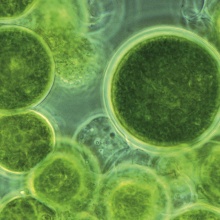Dr. Linus Stegbauer from the Institute of Interfacial Process Engineering and Plasma Technology (IGVP) at the University of Stuttgart has been successful in his application for funding as part of the Baden-Württemberg Foundation's Elite Program for postdocs. The project which is to receive funding focuses on the development of bio-intelligent façade elements for the construction industry. These elements are fitted with a special biofilm which contains living microalgae.
These single-cell plants can store moisture and thus have a cooling effect, as well as absorbing, breaking down and exploiting pollutants in the air. When used in building façades they can therefore make a valuable contribution towards improving the urban climate, and as a consequence indirectly towards the indoor climate as a kind of “collateral benefit”.
Also involved in the project alongside the IGVP, which plays the leading role, are Jun. Prof. Hanaa Dahy, Head of the BioMat Department (Biomaterials and Material Cycles in Architecture) from the Institute of Building Structures and Structural Design (ITKE) at the University of Stuttgart, as well as Dr. Ulrike Schmid-Staiger from the Fraunhofer Institute for Interfacial Engineering and Biotechnology (IGB).
As well as coordinating the project, the IGVP is also responsible for developing the necessary biofilm as part of the project. The Fraunhofer IGB contributes its expertise in algae technology, and investigates which type of microalgae is best suited for the intended purpose. The important factors here are the resilience of the plants – particularly with a view to environmental conditions such as drought, solar radiation etc – as well as the growth patterns of the algae. A high-throughput process is applied at the IGB for the purpose of choosing the suitable algae. The BioMat at the ITKE finally comes into play on the application side. The aim is ultimately to develop a demonstrator. The overall objective is to manufacture a prototype of a bio-intelligent façade element.
The use of microalgae in building façades is supported on the one hand by the ability of the plants to absorb CO2 and other substances from the air, such as e.g. highly toxic nitric oxides, and their ability to utilize them by means of their metabolism, and on the other hand by their rapid growth and more particularly by their robustness. This is what differentiates them from other plants which are used for similar purposes, such as for example moss. In dry conditions the algae go quiet – similar to hibernation – and can survive unharmed for a long period of time. As soon as they come into contact with moisture, such as after rainfall, they spring back into action again. By absorbing and storing water, they make sure that water is exchanged more slowly. This in turn has a cooling effect which can improve the urban climate. Due to their absorbing qualities, the single-cell organisms also reduce the amount of particulate matter and CO2 pollution in the air. This technology also offers huge potential for cost savings for the construction industry as well as for building operators – for example through reduced heating costs over the long term or the cost of air-conditioning thanks to the improved microclimate.
The biofilm, which serves as both a home and a breeding ground for the algae, is of key importance for its use in the construction industry. However, the material must still meet certain requirements, which poses a major challenge for the IGVP. The film must be transparent to ensure that algae get the light they need, and it must also have a sufficient capacity to absorb water. This is the only way that it can provide suitable living conditions for the algae to grow. At the same time, it also restricts the growth of the algae so that it cannot spread out of control.
The project is set to begin on January 1 and is due to last three years. The total project volume is 150,000 euros.


